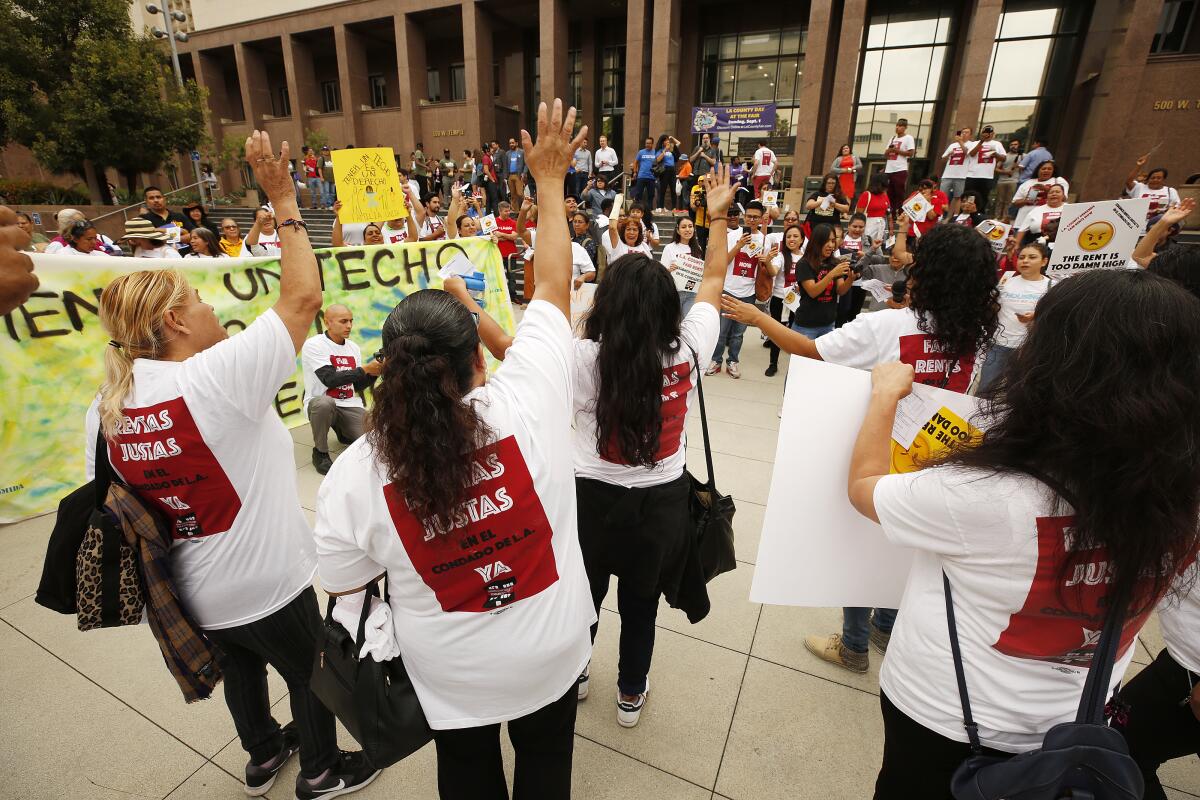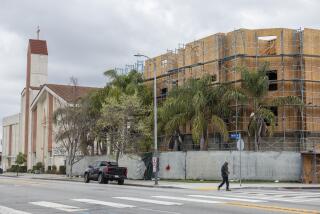L.A. County rent control and eviction rules advance for unincorporated areas

In a bid to provide tenants stability and combat rising homelessness, the Los Angeles County Board of Supervisors on Tuesday moved to make permanent a rent control measure for unincorporated communities.
In a 5-0 vote, officials asked staff to draft an ordinance that ties annual increases to inflation and requires landlords have âjust causeâ â such as not paying rent â before they evict tenants.
The new rules would apply to roughly 43,500 multifamily units built on or before Feb. 1, 1995, in unincorporated communities such as East L.A., Willowbrook and Rowland Heights. They would join the city of Los Angeles, Santa Monica, Beverly Hills and West Hollywood as local municipalities with permanent rent control measures.
If the measure had been in place in recent years, annual rent increases would have been capped at 3% or 4% â a rate that backers say protects tenants and allows landlords to make a reasonable return on their investment.
âWe see this as homelessness prevention and we want to take action to protect renters,â Supervisor Sheila Kuehl, who has pushed the measure, said in a news conference before the vote.
Landlord groups opposed the measure, saying it would force small apartment owners to raise rents where they otherwise wouldnât.
Tuesdayâs action was the latest effort to expand rentersâ rights in Southern California as homelessness has surged. Tenants have waged rent strikes and brought protests to landlordsâ homes.
Earlier this year, Inglewood and Culver City passed temporary rent control measures, and Pasadena, Long Beach and Glendale mandated relocation payments in certain situations.
Multiple data sources show the rate of increase in average rents has slowed countywide in recent years. But rents are up sharply since 2012 and some tenants still see big jumps, particularly after a new owner purchases a building.
Annual rent increases in older buildings have been capped at 3% in unincorporated areas under a temporary measure the board passed last year to give it room to craft a permanent version.
But before that temporary measure passed, some tenants saw their rent raised 30%, 60% and in one case 395%, according to the Los Angeles Center for Community Law and Action, which has been pushing for rent control.
Other landlords told all tenants to leave in 60 days â a popular strategy investors use in gentrifying neighborhoods to get rid of low-income households and renovate units for people whoâll pay more.
âEvery time we drove by an underpass, a park, a shaded sidewalk, I would wonder if it was a good place to set up our tents,â said East L.A. resident Carolina Rodriguez, whose 63% rent increase was a galvanizing story in the push for rent control in unincorporated communities.
Rodriguez beat back that rent increase through multiple court battles and remained in her home. But several recent studies have found rising rents in high-cost areas lead to increased homelessness, tipping already at-risk people into the streets.
Many in the apartment industry say politicians unfairly blame landlords for a complicated homeless problem, in which low-wage work or mental health can play a role.
The industry says most landlords arenât gouging tenants, but instead need flexibility for large increases so they can cover unexpected costs. Fred Sutton of the California Apartment Assn. argued capping rent will cause some mom-and-pop landlords who donât raise rent each year to do so, because they donât know when a big expense will hit.
â[Landlords] canât fall behind,â Sutton said. âIn the long run, you will make things more expensive.â
Once drafted, the permanent ordinance will return to the board for approval in November, but such votes are often formalities.
In covered buildings in unincorporated areas, allowable rent increases would equal the change in the consumer price index, except in certain situations.
Rent increases generally couldnât be higher than 8%. If inflation was 1% or 2%, the most rents could rise would be 3%. If inflation fell below 1%, allowable rent increases would be less than 3% and perhaps as low as zero.
Supervisor Kathryn Barger, who was against the temporary measure, voted to draft a permanent ordinance. Her spokesperson said the permanent measure strikes a balance between landlord and tenant rights, in part because it would allow landlords a way to pass along costs of major capital improvements, such as a roof repair.
Under state law, landlords of rent-controlled units also have the right to charge as much as they want when a tenant moves out. But when a new tenant moves in, landlords are once again limited on how much they can increase rent each year.
Such vacancy rules are mandated by the Costa-Hawkins Act, which also prohibits rent control on single-family homes and multifamily units built after Feb. 1, 1995.
The countyâs permanent âjust causeâ protections would also apply to units built after the February 1995 date, as well as single-family homes.
The board also voted Tuesday to establish eviction defense services for tenants and to study requiring relocation payments if sharp rent increases force people from non-rent-controlled properties.
Many economists say the root cause of Californiaâs affordability woes is that for decades too few homes have been built relative to population and job growth. And they argue that while rent control helps some tenants, it puts upward pressure on rents overall as some landlords decide to get out of the business and convert units to condos.
Brian Asquith, an economist with the Michigan-based Upjohn Institute, said rent control can be a good short-term policy to stop dramatic increases and slow gentrification. But he said in the long term, policymakers should remove controls and allow more housing to be built so landlords donât have the leverage to demand 50% hikes.
Tenant rights groups say the private market will never build enough to make housing affordable. They worry that allowing more development would allow even more investors to displace low-income households.
Instead, they argue that housing should be treated like a regulated utility and that, in addition to rent caps, state law should be changed so governments can ban property owners from removing units from the rental market.
âWe need to stop the commodification of housing and start treating people over profit,â Kimberly Miranda, an East L.A. resident and tenant activist, told the county supervisors.
The state Legislature isnât considering letting local governments ban the removal of rental housing. But on Tuesday the state Senate passed a statewide bill that would cap annual increases for the next decade at 5% plus inflation for buildings more than 15 years old, including single-family homes that are owned by corporations or other institutional investors.
If that bill becomes law, it would not override existing rent control ordinances like the one the Board of Supervisors voted to draft Tuesday.
The California Apartment Assn. decided not to oppose the state bill. In an email explaining its decision to members, the group said passage could bring âindirect political benefitsâ because tenant activists and progressive local governments âmay be less likely to seek their own rent-control measures.â
On Tuesday, before the L.A. County vote, activists and county political leaders held a news conference and called for more cities to pass their own rent control measures, arguing the state bill is not enough.
Activists then marched through Grand Park and down the street, chanting, âHousing is a human right! Fight! Fight! Fight!â
Times staff writer Liam Dillon contributed to this report.
More to Read
Inside the business of entertainment
The Wide Shot brings you news, analysis and insights on everything from streaming wars to production â and what it all means for the future.
You may occasionally receive promotional content from the Los Angeles Times.











